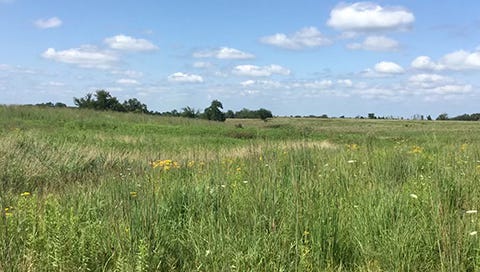Navigating the 2025 Conservation Reserve Program
Lower Rates and Shifting Incentives are a Result of the Lack of a Farm Bill
On May 12, 2025, FSA announced the signup period for Continuous and General Conservation Reserve Program (CRP) enrollment.
This long-awaited announcement opened signup for two portions of the world's largest private lands conservation program, with the third, grassland CRP, to be announced at a later date. While the program’s roots can be traced back to the Food Security Act of 1985, CRP as Americans know it today has much more modern applications.

For those new to CRP, the program allows farmers, ranchers, and landowners to offer land for enrollment based on an environmental need. If accepted, the participant would follow a conservation plan, developed with the Natural Resource Conservation Service (NRCS), and in exchange, receive an annual rental rate. CRP can be used to offset lost production costs on marginal, fringe, or sensitive land.
CRP: An Economic Boon for Rural Communities
Beyond the direct financial support for farmers and landowners, the Conservation Reserve Program plays a vital role in strengthening the economic fabric of rural communities. The annual rental payments participants receive provide a stable and predictable income stream, helping to diversify farm income and mitigate the volatility of commodity markets. This consistent revenue often circulates within local economies, supporting businesses such as farm supply stores, equipment dealers, and other service providers, thereby creating a positive ripple effect.
In states like Colorado, CRP also contributes to the thriving outdoor recreation industry. Lands enrolled in CRP, particularly those managed for wildlife habitat, can enhance opportunities for hunting, birdwatching, and other nature-based tourism. These activities attract visitors and inject dollars into local economies, supporting motels, restaurants, and sporting goods retailers. By fostering healthier landscapes, CRP not only provides ecological benefits but also creates a more resilient and diversified economic future for our rural towns.
CRP can be used in tandem with crop production
Throughout much of the Midwest, CRP can be used alongside row crop production. For farmers operating irrigated cropland, the field “corners” created by center pivot irrigation systems can be enrolled into the program and planted with wildlife cover. For farmers working land that is consistently wet, they can enroll that land into a grass waterway or possibly enroll it as a farmable wetland. While accomplishing the goals of their farming operations, farmers, ranchers, and landowners can also earn income from these fringe lands.
CRP is a tool for public health
As many states see historically low levels of rainfall, CRP can be used to secure topsoil and protect the land from creating dust storms that cause low air quality. In much of my home state of Colorado, rural towns across the eastern portion of the state are subject to loose topsoil being picked up by winds, causing low visibility and poor air quality. In years past, research has shown that when farmers, ranchers, and landowners enter land into CRP, they have improved air quality.
FSA’s 63rd and 64th CRP signups contain some changes
This year, CRP signup for both continuous and general CRP enrollment will run from May 12 to June 6, 2025. During this window, farmers, ranchers, and landowners will be able to visit their local FSA Service Center to submit an offer through either, or both, signups. People interested in enrolling should come prepared to the office with the land they would like to enroll in the program and an idea of what type of cover they would be interested in installing. For example, a person with an eroding streambank would identify the land, determine they would want to do something to stop the stream from continuing to erode cropland, and have determined they are willing to install a tree or a shrub. This will not only assist in determining the type of enrollment that may be best, but will also ensure that the application process goes smoothly.
Annual rental rates will be lower this year compared to last year’s annual rental rate calculation. In previous signups, land enrolled in CRP received certain incentives based on the type of cover installed on the land. Most notably, most acres enrolled in CRP under the 2018 Farm Bill received a 10% incentive, which was attributed to assisting in addressing inflation. Additional incentives were also offered depending on which type of “practice” (the type of cover installed and the specific environmental concern the acreage was trying to address) was installed. This incentive was designed to encourage participation in practices that had higher benefits to address climate change.
As the CRP program is authorized by the 2018 Farm Bill and a new Farm Bill has not been passed, people interested in enrolling in CRP should strongly consider applying this year. Without the passage of a full Farm Bill or another extension, a CRP enrollment period is not guaranteed in future years.
Registration is now open for the virtual Rural Progress Summit July 8-10
SOUND OFF
Are you a farmer that has benefited from CRP? Tell us your story. Email: podcast@onecountryproject.com and your feedback could be on an upcoming episode of The Hot Dish.




